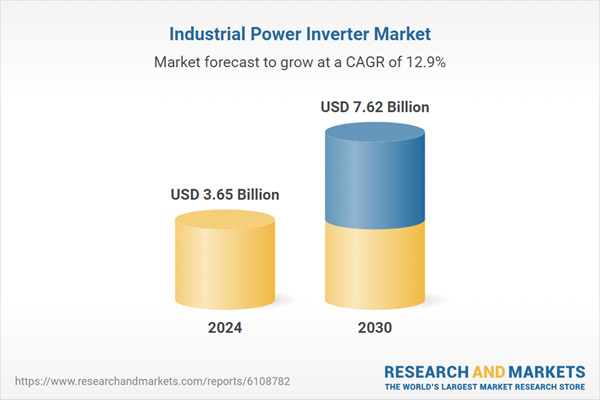Speak directly to the analyst to clarify any post sales queries you may have.
10% Free customizationThis report comes with 10% free customization, enabling you to add data that meets your specific business needs.
Key Market Drivers
Rising Demand for Energy-Efficient and Sustainable Power Solutions
A primary driver of the Industrial Power Inverter Market is the increasing emphasis on energy efficiency and sustainability across industrial sectors. As regulatory frameworks tighten and industries strive to cut energy costs and reduce greenhouse gas emissions, there is a growing need for power conversion systems that support renewable energy integration and efficient energy usage. Industrial inverters are pivotal in enabling the transition to cleaner power sources such as solar and wind by efficiently converting DC energy into usable AC power. Their ability to manage energy flow and maintain grid stability makes them essential for meeting environmental compliance and achieving energy optimization goals in large-scale operations.Key Market Challenges
High Initial Investment and Integration Complexity
A key challenge in the Industrial Power Inverter Market is the substantial capital required for procurement, installation, and system integration. High-capacity inverter solutions, particularly those used in renewable energy or mission-critical applications, come with elevated costs that include not just the main units but also auxiliary systems such as control modules, protection gear, and cooling technologies.Moreover, many industrial setups still operate on legacy systems that may not be compatible with modern inverter technologies. Integrating new inverters often requires extensive retrofitting, redesign of electrical systems, and software interface customization. This complexity increases total project costs and necessitates skilled labor for proper configuration and commissioning. In some cases, installation may require operational downtime, further impacting productivity and return on investment. These integration challenges are particularly burdensome for small and mid-sized enterprises with limited budgets and technical capacity.
Key Market Trends
Proliferation of Renewable Energy Integration
The rapid expansion of renewable energy is significantly influencing the Industrial Power Inverter Market. As industries adopt solar and wind power solutions, the need for robust inverter systems capable of handling distributed energy generation and grid synchronization is growing. In solar PV systems, large-scale three-phase and central inverters are essential for converting DC to grid-compatible AC while also providing grid support functions like reactive power control and voltage stabilization.Wind farms similarly rely on advanced inverters to manage varying input frequencies and ensure compatibility with transmission networks. Industrial facilities, utilities, and corporate entities are increasingly deploying hybrid power systems that combine renewable energy with energy storage, microgrids, and EV charging stations. This evolution is fueling demand for modular inverters that support features like islanding, real-time load balancing, and seamless integration with digital monitoring platforms.
As smart grid initiatives advance, OEMs are incorporating IoT sensors, cloud-based analytics, and AI-driven diagnostics into their inverter systems. These smart inverters enhance asset management, ensure grid code compliance, and improve lifecycle performance, aligning with the broader digital transformation in industrial power systems.
Key Market Players
- Schneider Electric SE
- Siemens AG
- ABB Ltd.
- Mitsubishi Electric Corporation
- Eaton Corporation plc
- Toshiba Corporation
- Hitachi, Ltd.
- Fuji Electric Co., Ltd.
- Delta Electronics, Inc.
- Yaskawa Electric Corporation
Report Scope:
In this report, the Global Industrial Power Inverter Market has been segmented into the following categories, in addition to the industry trends which have also been detailed below:Industrial Power Inverter Market, By Type:
- Single-phase Inverters
- Three-phase Inverters
- Multiphase Inverters
Industrial Power Inverter Market, By Power Rating:
- < 100 kW
- 100-500 kW
- >500 kW
Industrial Power Inverter Market, By Application:
- Renewable Energy Systems
- Motor Drives & Pumps
- Uninterruptible Power Supplies (UPS)
- HVAC Systems
- Automation & Control Systems
- Welding & Industrial Equipment
Industrial Power Inverter Market, By Region:
- North America
- United States
- Canada
- Mexico
- Europe
- France
- United Kingdom
- Italy
- Germany
- Spain
- Asia-Pacific
- China
- India
- Japan
- Australia
- South Korea
- South America
- Brazil
- Argentina
- Colombia
- Middle East & Africa
- South Africa
- Saudi Arabia
- UAE
- Kuwait
- Turkey
Competitive Landscape
Company Profiles: Detailed analysis of the major companies present in the Global Industrial Power Inverter Market.Available Customizations:
With the given market data, the publisher offers customizations according to a company's specific needs. The following customization options are available for the report.Company Information
- Detailed analysis and profiling of additional Market players (up to five).
This product will be delivered within 1-3 business days.
Table of Contents
Companies Mentioned
- Schneider Electric SE
- Siemens AG
- ABB Ltd.
- Mitsubishi Electric Corporation
- Eaton Corporation plc
- Toshiba Corporation
- Hitachi, Ltd.
- Fuji Electric Co., Ltd.
- Delta Electronics, Inc.
- Yaskawa Electric Corporation
Table Information
| Report Attribute | Details |
|---|---|
| No. of Pages | 180 |
| Published | July 2025 |
| Forecast Period | 2024 - 2030 |
| Estimated Market Value ( USD | $ 3.65 Billion |
| Forecasted Market Value ( USD | $ 7.62 Billion |
| Compound Annual Growth Rate | 12.8% |
| Regions Covered | Global |
| No. of Companies Mentioned | 10 |









